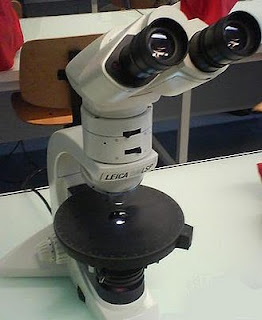A petrographic microscope is an optical microscope commonly employed in petrology and optical mineralogy to identify rocks and minerals in thin sections. Petrographic microscopes are built with optical parts that do not add unwanted polarizing effects due to strained glass, or polarization by reflection in prisms and mirrors. These special parts add to the cost and complexity of the microscope. Nevertheless, a "simple polarizing" microscope is easily made by adding inexpensive polarizing filters to a standard biological microscope, often with one in a filter holder beneath the condenser, and a second inserted beneath the head or eyepiece.
The two filters of the petrographic microscope have their polarizing planes oriented perpendicular to one another. When only an isotropic material such as air, water, or glass exists between the filters, all light is blocked. However, most crystalline materials and minerals change the polarizing light directions, which allows some of the altered light to pass through the analyzer to the viewer. Using one polarizer allows for looking at the slide in plane polarized light, while using two allows for analysis under cross polarized light.
A particular light pattern on the upper lens surface of the objectives is created as an conoscopic interference pattern characteristic of uniaxial and biaxial minerals, and produced with convergent polarized light. To observe the interference figure, true petrographic microscopes usually include an accessory called a Bertrand lens, which focuses and enlarges the figure. It is also possible to remove an eyepiece lens to make a direct observation of the objective lens surface.

No comments:
Post a Comment